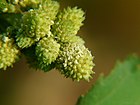Note: This is a project under development. The articles on this wiki are just being initiated and broadly incomplete. You can Help creating new pages.
Difference between revisions of "Xanthium strumarium"
(→Identification) |
|||
| Line 37: | Line 37: | ||
===Flower=== | ===Flower=== | ||
| − | {{Flower|Numerous||White or green|Male uppermost, Female ovoid, Covered with hooked bristles}} | + | {{Flower|Numerous||White or green|Male uppermost, Female ovoid, Covered with hooked bristles, Flowering season is August-September}} |
===Fruit=== | ===Fruit=== | ||
| − | {{Fruit|Obovoid|||||Enclosed in the hardened involucre with 2 hooles beaks and hooked bristle}} | + | {{Fruit|Obovoid|||||Enclosed in the hardened involucre with 2 hooles beaks and hooked bristle, Fruiting season is August-September}} |
===Other features=== | ===Other features=== | ||
Latest revision as of 16:36, 20 May 2021
Xanthium strumarium is an annual plant that can grow up to 0.75 metres tall. It is harvested from the wild for local use as a food, medicine and source of materials.
Contents
- 1 Uses
- 2 Parts Used
- 3 Chemical Composition
- 4 Common names
- 5 Properties
- 6 Habit
- 7 Identification
- 8 List of Ayurvedic medicine in which the herb is used
- 9 Where to get the saplings
- 10 Mode of Propagation
- 11 How to plant/cultivate
- 12 Commonly seen growing in areas
- 13 Photo Gallery
- 14 References
- 15 External Links
Uses
Malaria, Rheumatism, Tuberculosis, Allergic rhinitis, Sinusitis, Catarrh, Rheumatoid arthritis, Constipation, Diarrhoea, Lumbago, Leprosy.[1]
Parts Used
Chemical Composition
The main components of the oil were β-caryophyllene (17.53%), α-cadinol (6.66%), spathulenol (6.09%), limonene (5.66%) and 1,3,5-trimethyl-2[2-nitroallyl]benzene (3.29%) etc.[2]
Common names
| Language | Common name |
|---|---|
| Kannada | ಮರುಳೂಮ್ಮತ್ತಿ Maruluummatti |
| Hindi | Chota dhatura |
| Malayalam | |
| Tamil | Marul-umattai |
| Telugu | Marulutige |
| Marathi | Ghagara |
| Gujarathi | Godrian |
| Punjabi | |
| Kashmiri | |
| Sanskrit | Arishta |
| English | Common Cocklebur, Broad bur |
Properties
Reference: Dravya - Substance, Rasa - Taste, Guna - Qualities, Veerya - Potency, Vipaka - Post-digesion effect, Karma - Pharmacological activity, Prabhava - Therepeutics.
Dravya
Rasa
Guna
Veerya
Vipaka
Karma
Prabhava
Habit
Identification
Leaf
| Kind | Shape | Feature |
|---|---|---|
| Large and broad leaves | Light and bright green in colour in an alternate pattern with irregular lobes |
Flower
| Type | Size | Color and composition | Stamen | More information |
|---|---|---|---|---|
| Numerous | White or green | Male uppermost, Female ovoid, Covered with hooked bristles, Flowering season is August-September | {{{5}}} |
Fruit
| Type | Size | Mass | Appearance | Seeds | More information |
|---|---|---|---|---|---|
| Obovoid | Enclosed in the hardened involucre with 2 hooles beaks and hooked bristle, Fruiting season is August-September |
Other features
List of Ayurvedic medicine in which the herb is used
Where to get the saplings
Mode of Propagation
How to plant/cultivate
Requires a sunny position, succeeding in most soils. Prefers a poor dry soil.[5]
Commonly seen growing in areas
River banks, Lake shores, Cultivated ground.
Photo Gallery
References
- ↑ Indian Medicinal Plants by C.P.Khare
- ↑ Chemical constituents
- ↑ Common names
- ↑ Kappatagudda - A Repertoire of Medicianal Plants of Gadag by Yashpal Kshirasagar and Sonal Vrishni, Page No. 396
- ↑ Cultivation
External Links
- Ayurvedic Herbs known to be helpful to treat Malaria
- Ayurvedic Herbs known to be helpful to treat Rheumatism
- Ayurvedic Herbs known to be helpful to treat Tuberculosis
- Ayurvedic Herbs known to be helpful to treat Allergic rhinitis
- Ayurvedic Herbs known to be helpful to treat Sinusitis
- Ayurvedic Herbs known to be helpful to treat Catarrh
- Ayurvedic Herbs known to be helpful to treat Rheumatoid arthritis
- Ayurvedic Herbs known to be helpful to treat Constipation
- Ayurvedic Herbs known to be helpful to treat Diarrhoea
- Ayurvedic Herbs known to be helpful to treat Lumbago
- Ayurvedic Herbs known to be helpful to treat Leprosy
- Herbs with Leaves used in medicine
- Herbs with Young plants used in medicine
- Herbs with Seeds used in medicine
- Herbs with common name in Kannada
- Herbs with common name in Hindi
- Herbs with common name in Tamil
- Herbs with common name in Telugu
- Herbs with common name in Marathi
- Herbs with common name in Gujarathi
- Herbs with common name in Sanskrit
- Herbs with common name in English
- Habit - Annual
- Index of Plants which can be propagated by Seeds
- Herbs that are commonly seen in the region of River banks
- Herbs that are commonly seen in the region of Lake shores
- Herbs that are commonly seen in the region of Cultivated ground
- Herbs










